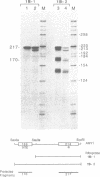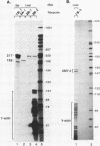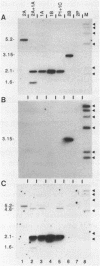Abstract
The human genes encoding salivary amylase (AMY1) and pancreatic amylase (AMY2) are nearly identical in structure and sequence. We have used ribonuclease protection studies to identify the functional gene copies in this multigene family. Riboprobes derived from each gene were hybridized to RNA from human pancreas, parotid and liver. The sizes of the protected fragments demonstrated that both pancreatic genes are expressed in pancreas. One of the pancreatic genes, AMY2B, is also transcribed at a low level in liver, but not from the promoter used in pancreas. AMY1 transcripts were detected in parotid, but not in pancreas or liver. Unexpected fragments protected by liver RNA led to the discovery that the 5' regions of the five human amylase genes contain a processed gamma-actin pseudogene. The promoter and start site for transcription of AMY1 are recently derived from the 3' untranslated region of gamma-actin. In addition, insertion of an endogenous retrovirus has interrupted the gamma-actin pseudogene in four of the five amylase genes.
Full text
PDF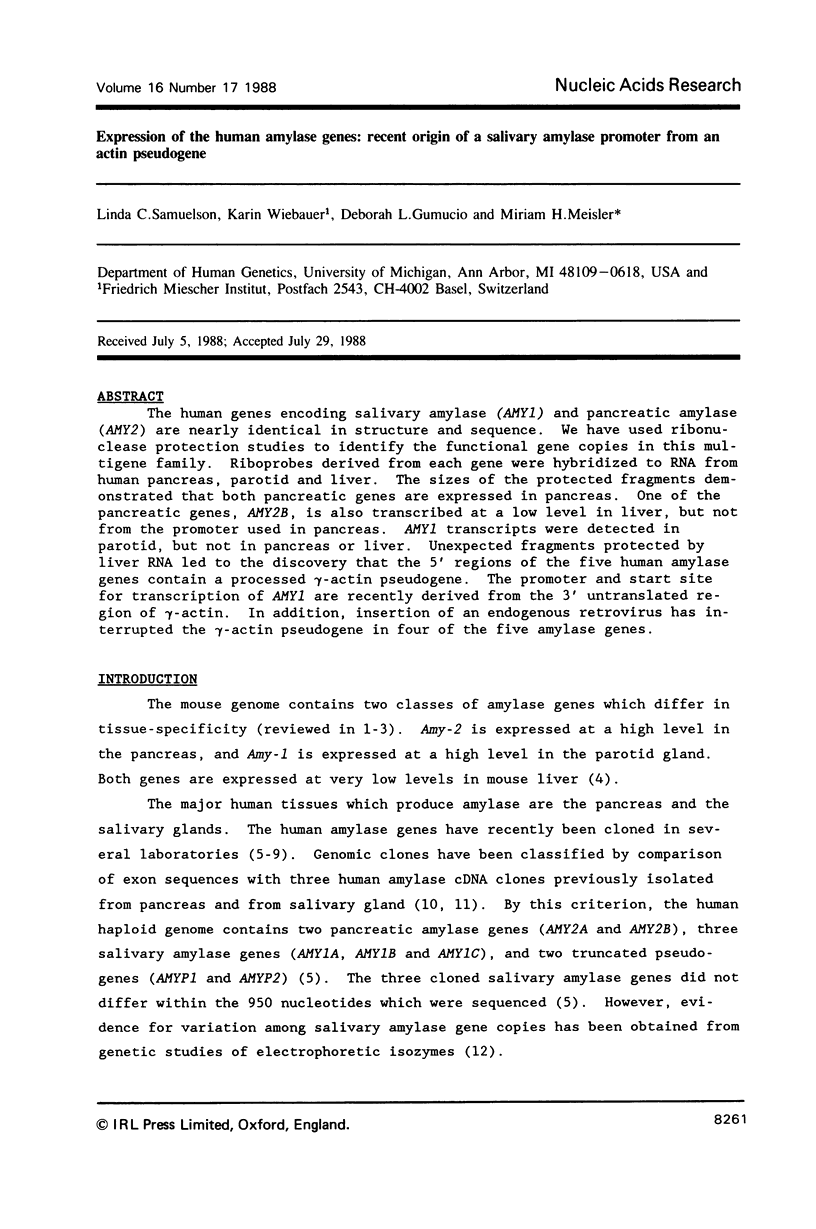
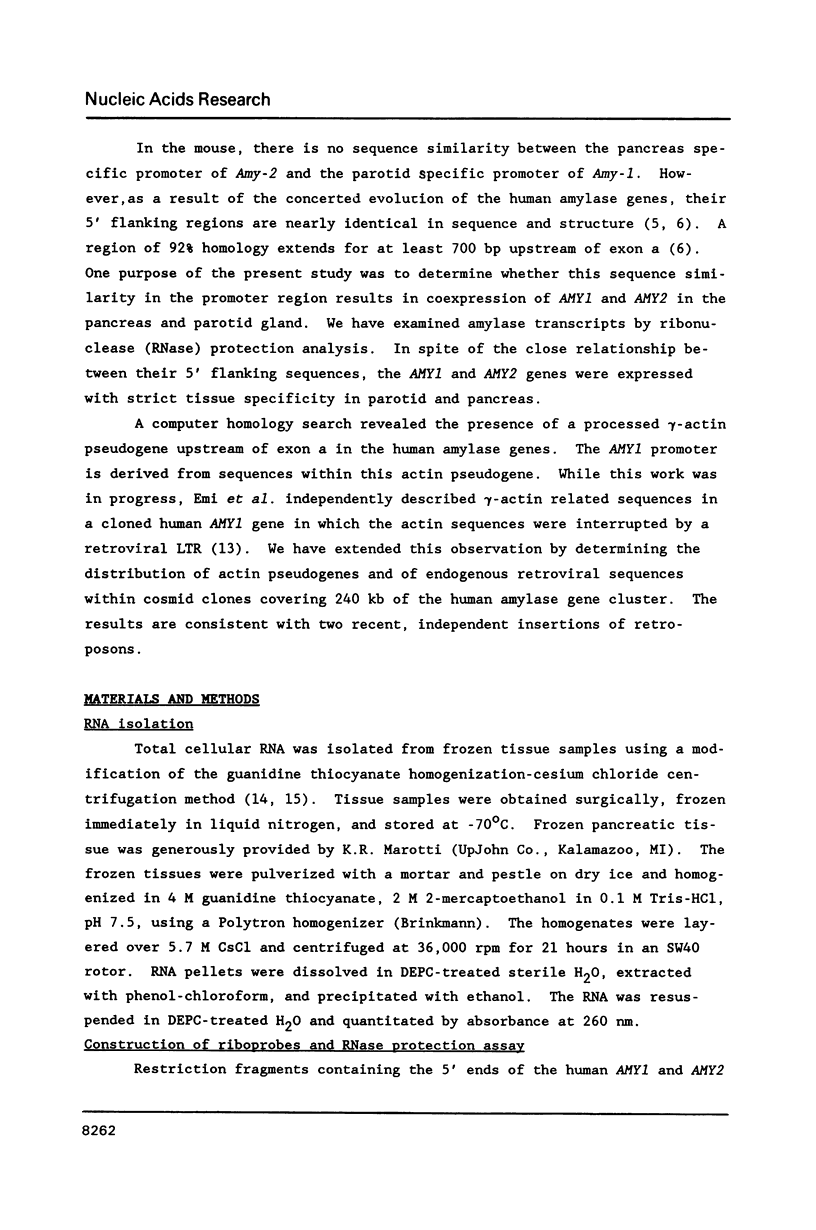
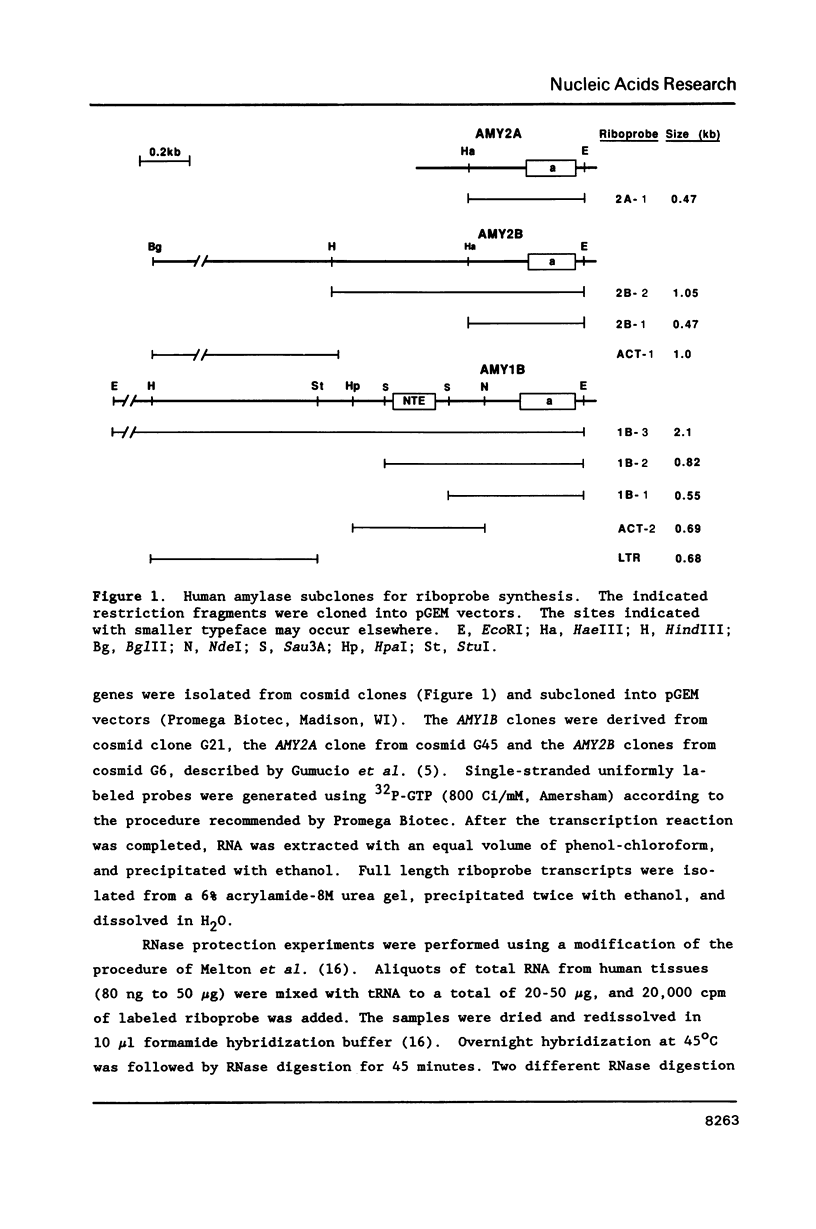
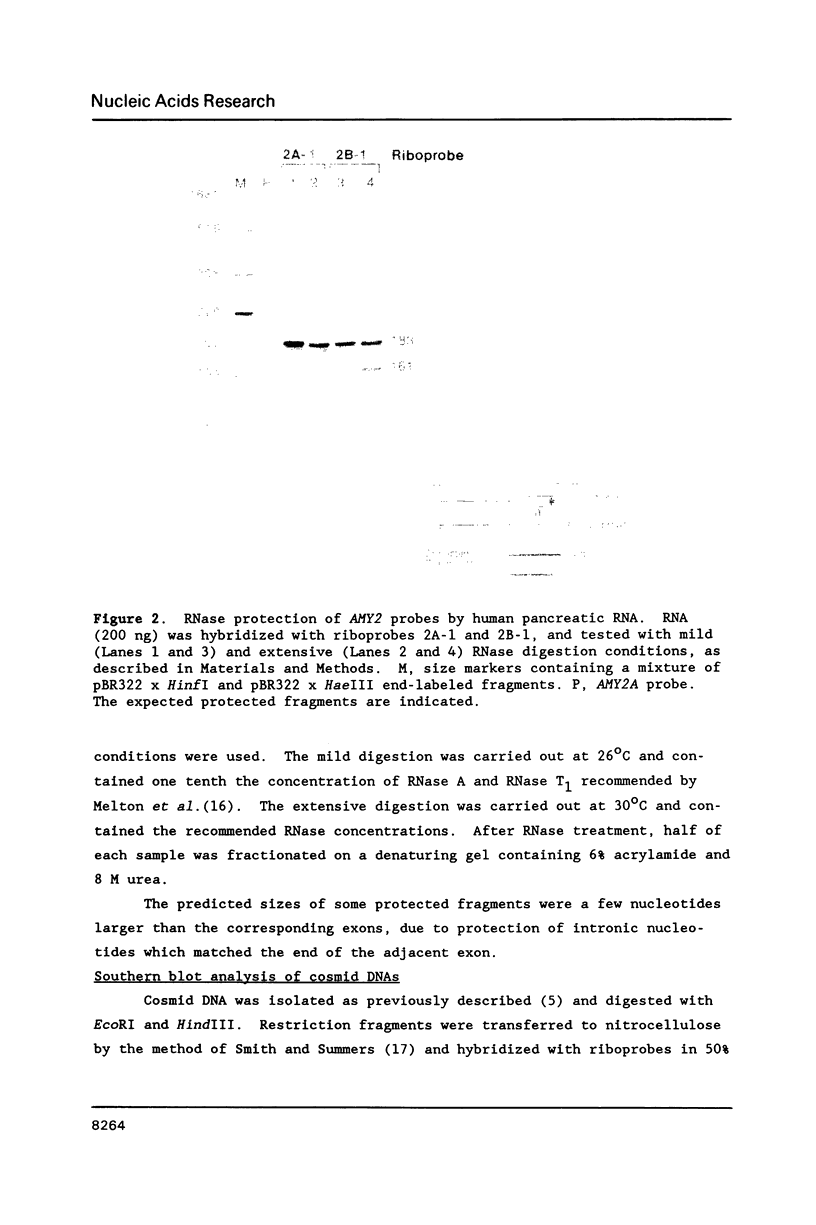
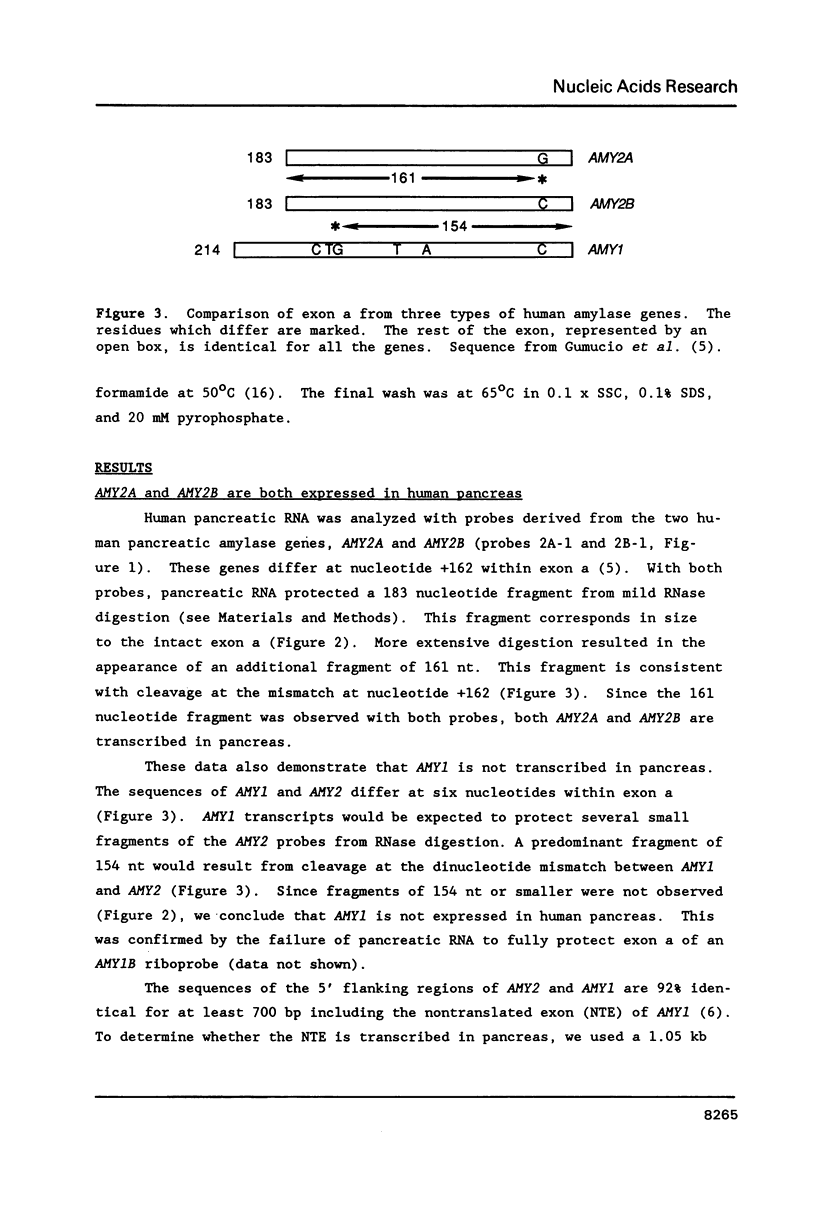
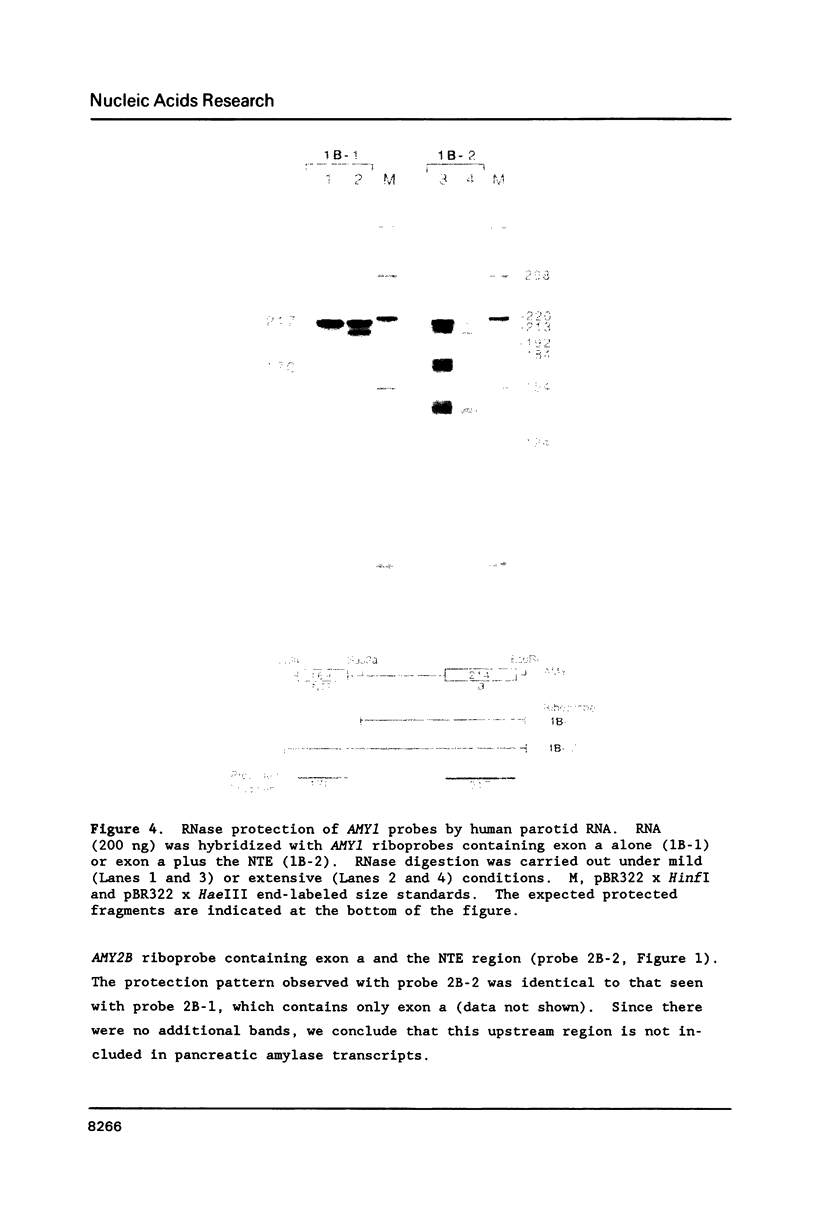
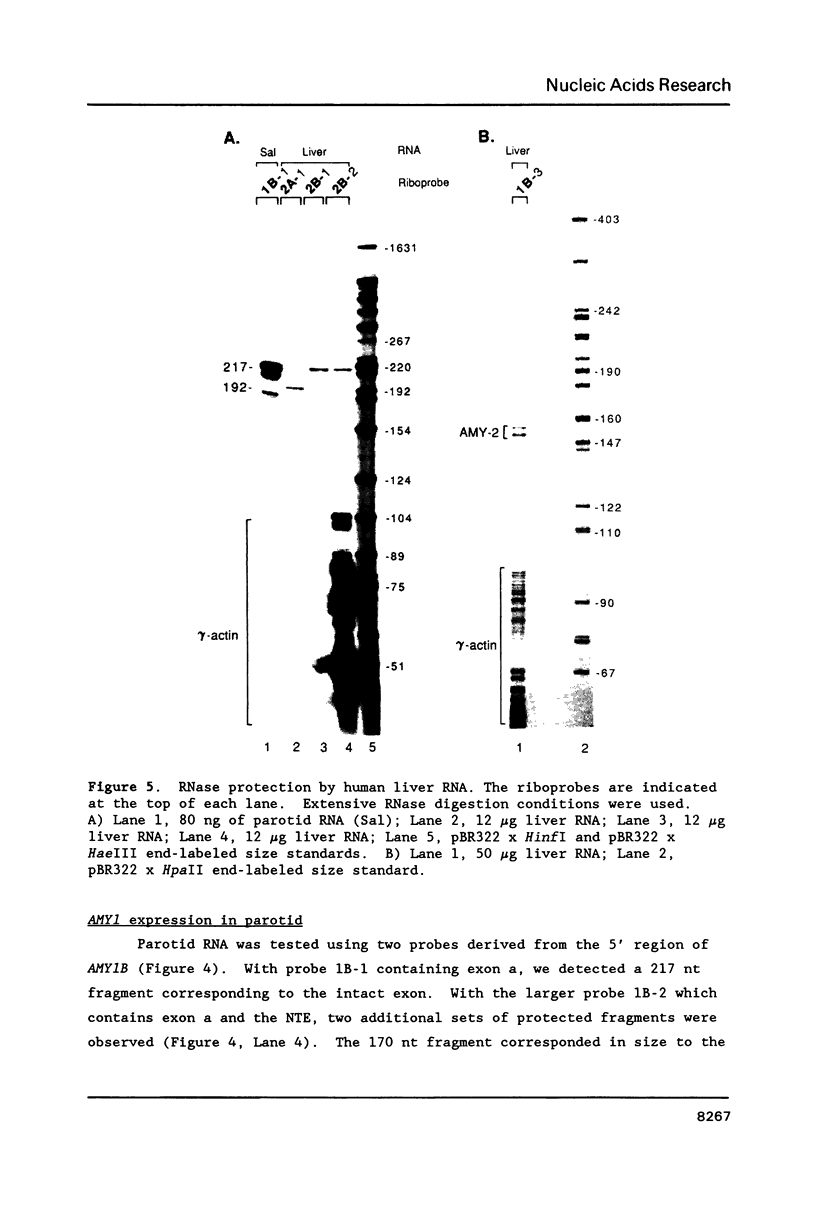

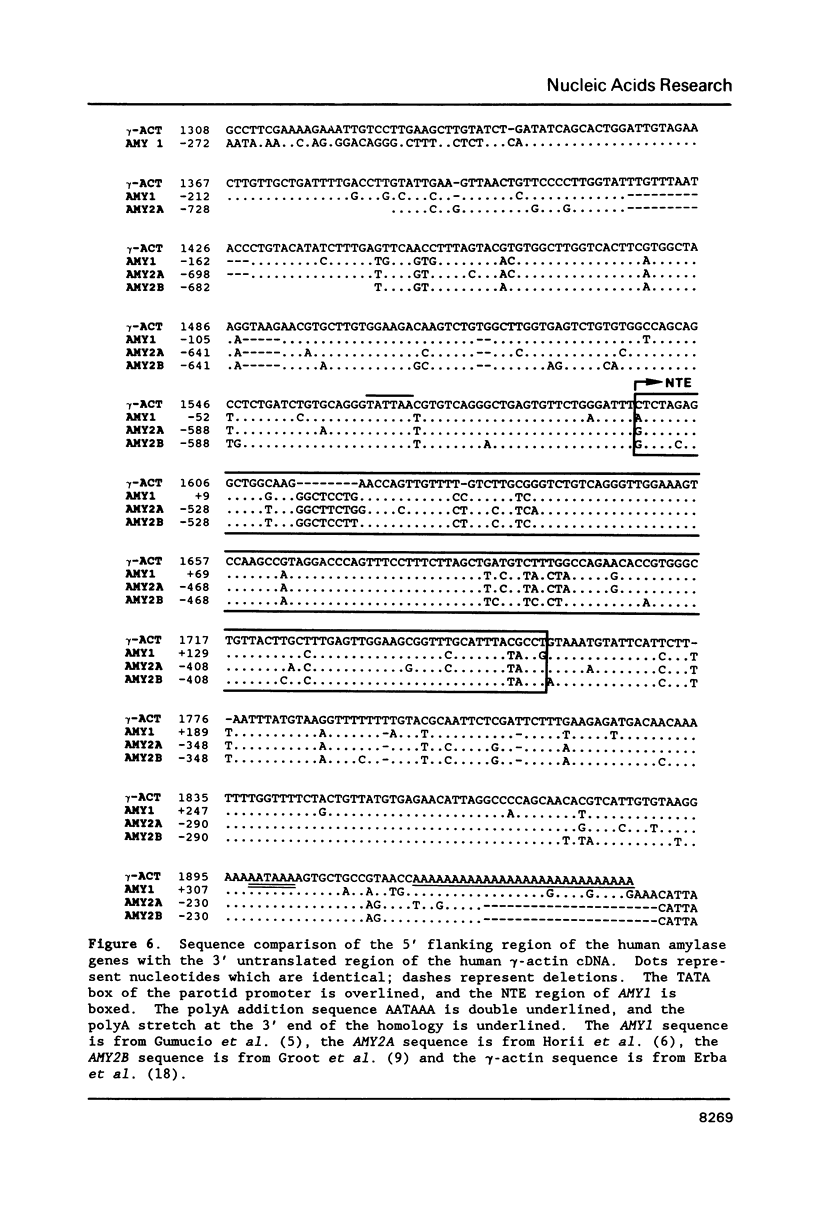
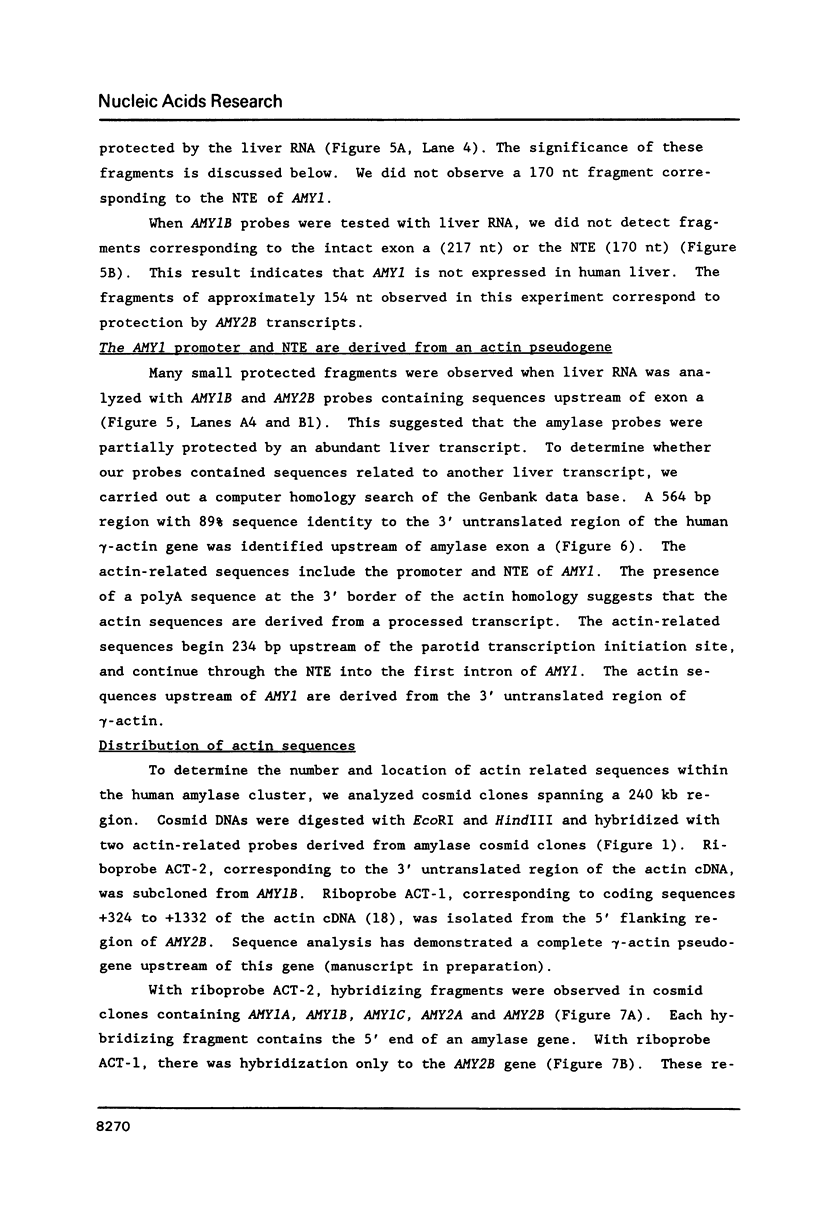
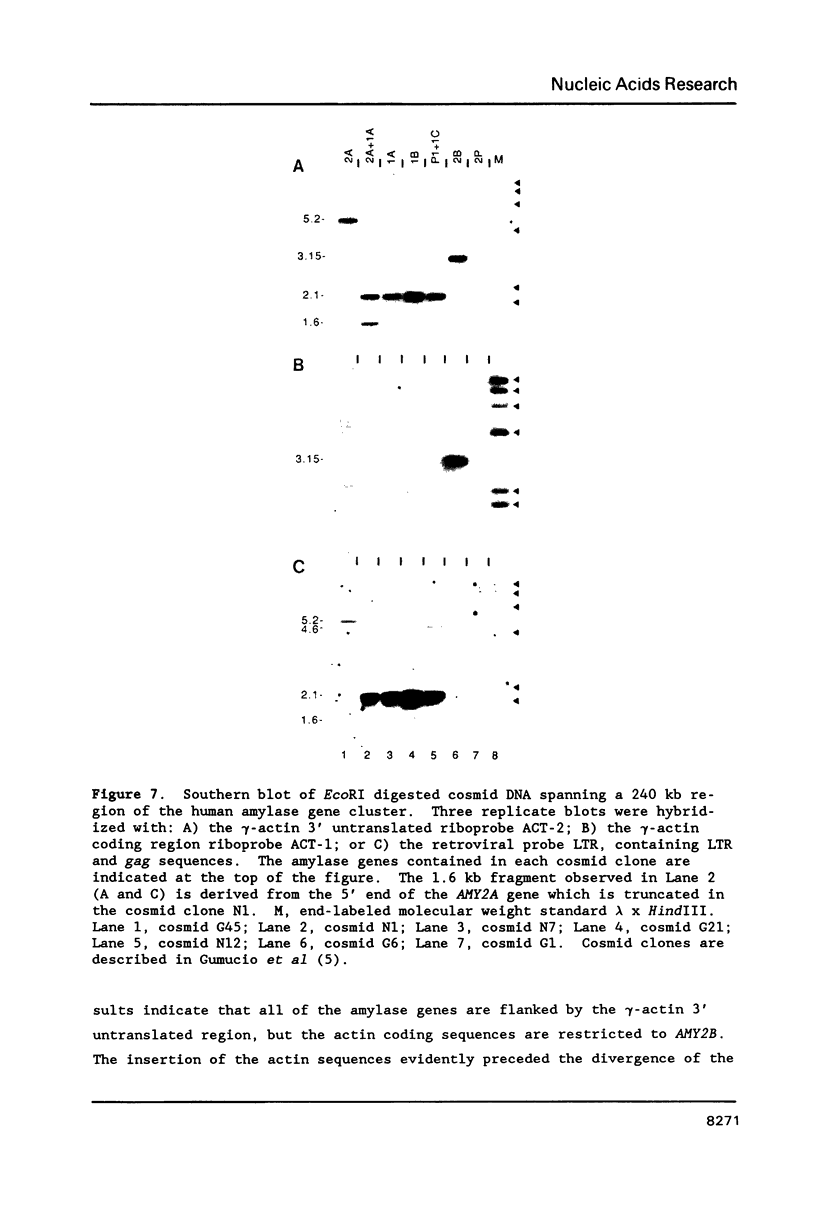
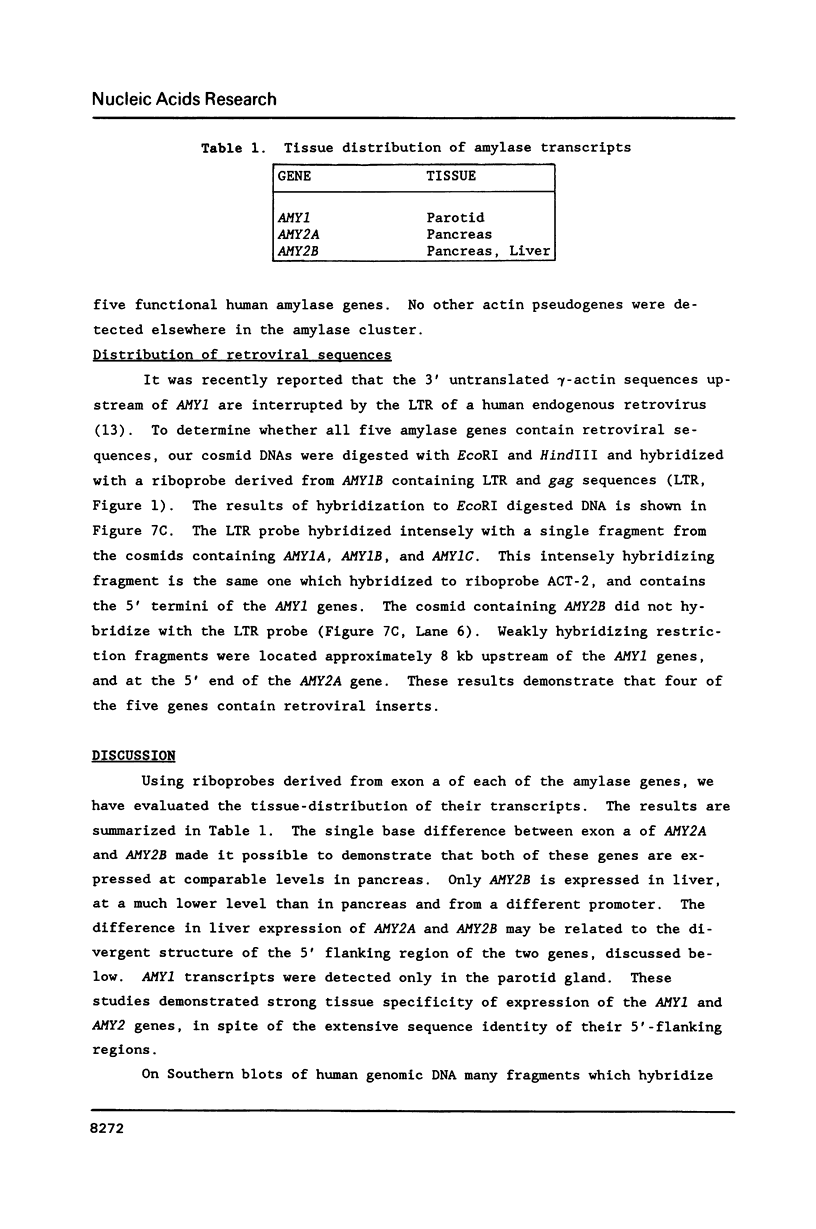
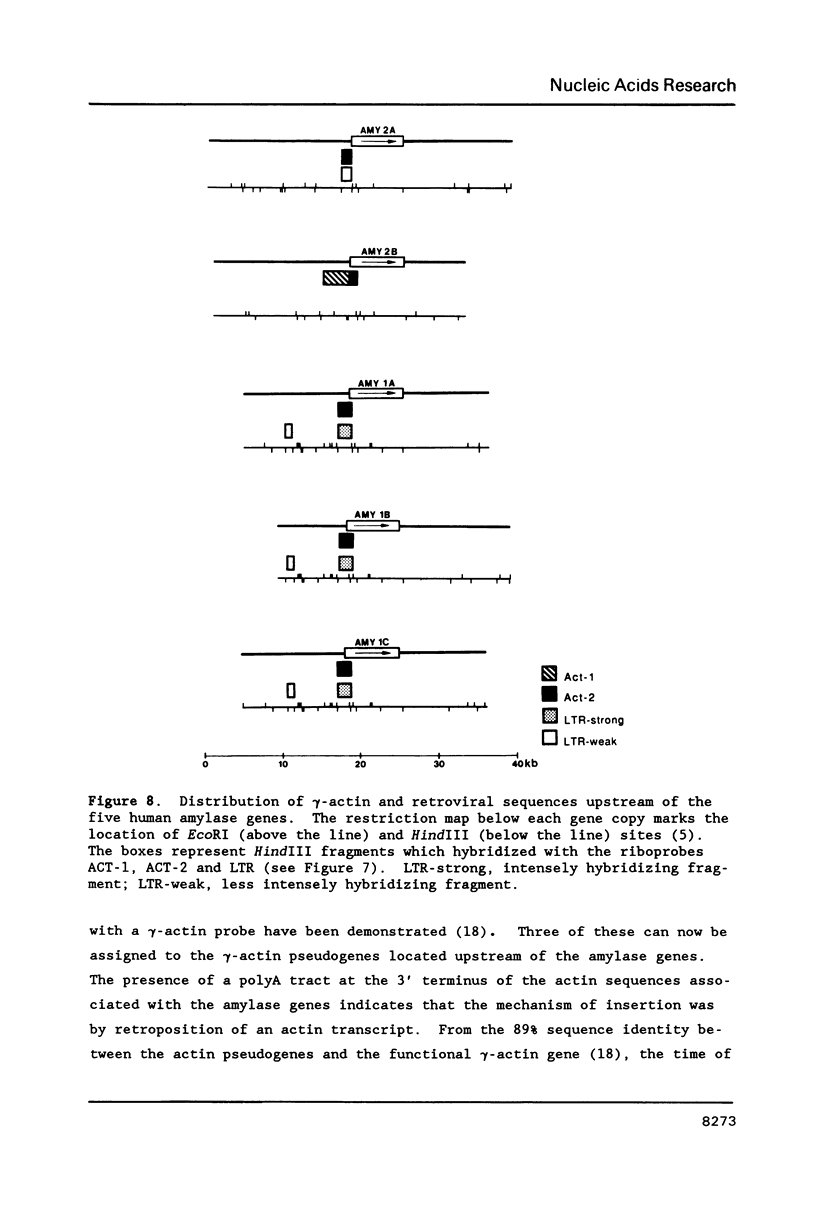
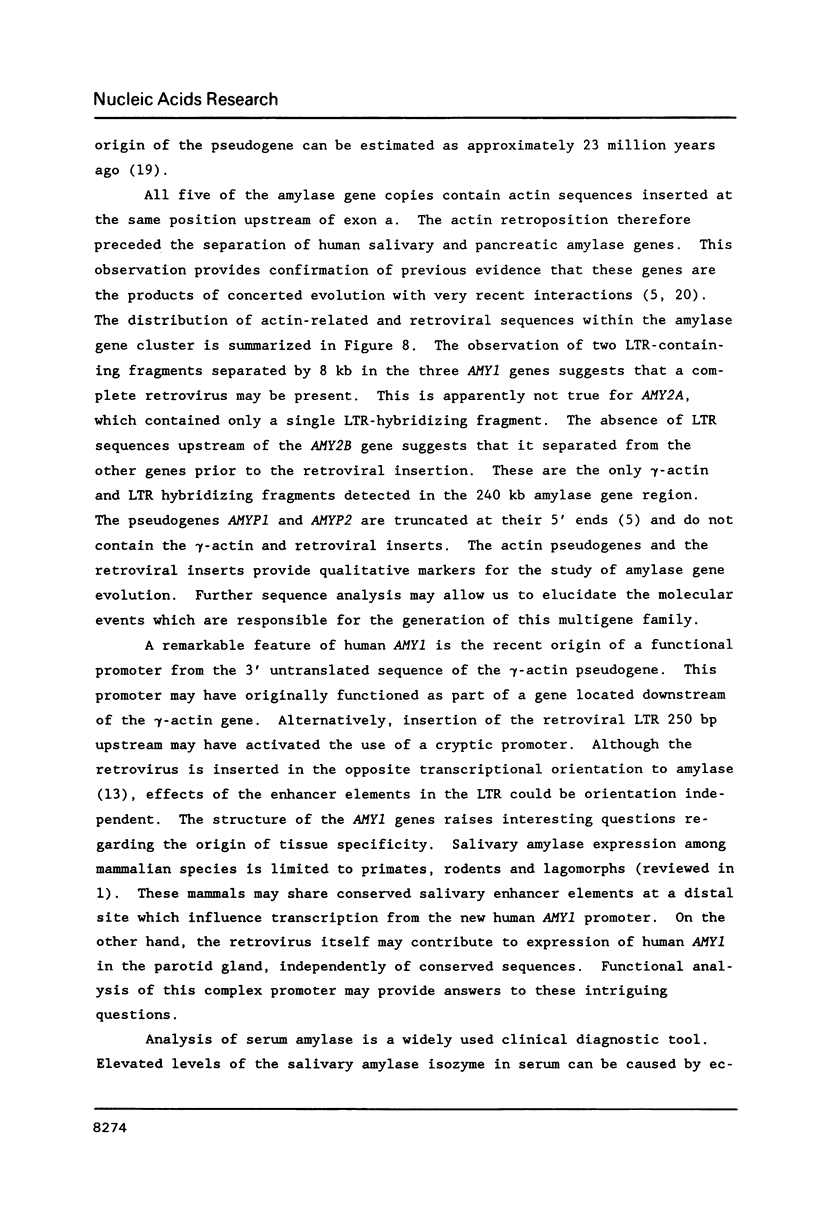
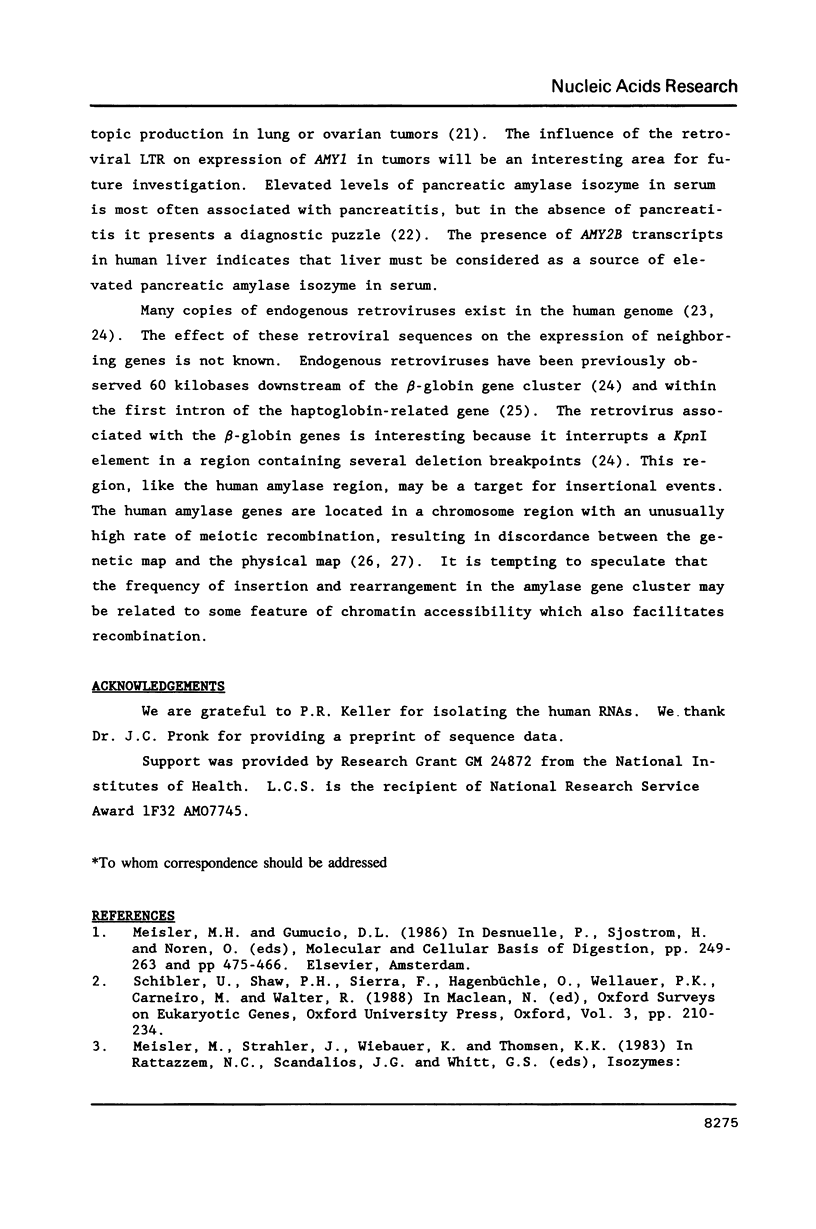
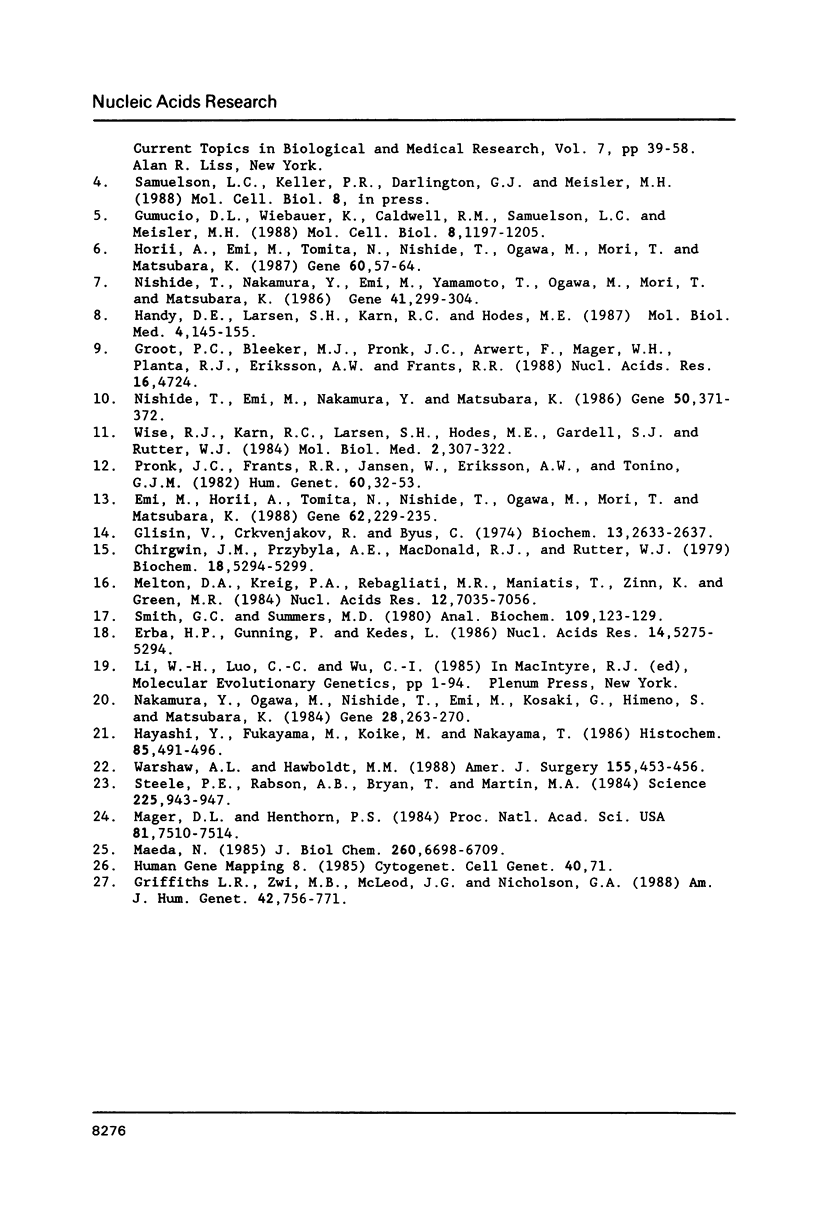
Images in this article
Selected References
These references are in PubMed. This may not be the complete list of references from this article.
- Chirgwin J. M., Przybyla A. E., MacDonald R. J., Rutter W. J. Isolation of biologically active ribonucleic acid from sources enriched in ribonuclease. Biochemistry. 1979 Nov 27;18(24):5294–5299. doi: 10.1021/bi00591a005. [DOI] [PubMed] [Google Scholar]
- Emi M., Horii A., Tomita N., Nishide T., Ogawa M., Mori T., Matsubara K. Overlapping two genes in human DNA: a salivary amylase gene overlaps with a gamma-actin pseudogene that carries an integrated human endogenous retroviral DNA. Gene. 1988;62(2):229–235. doi: 10.1016/0378-1119(88)90561-6. [DOI] [PubMed] [Google Scholar]
- Erba H. P., Gunning P., Kedes L. Nucleotide sequence of the human gamma cytoskeletal actin mRNA: anomalous evolution of vertebrate non-muscle actin genes. Nucleic Acids Res. 1986 Jul 11;14(13):5275–5294. doi: 10.1093/nar/14.13.5275. [DOI] [PMC free article] [PubMed] [Google Scholar]
- Glisin V., Crkvenjakov R., Byus C. Ribonucleic acid isolated by cesium chloride centrifugation. Biochemistry. 1974 Jun 4;13(12):2633–2637. doi: 10.1021/bi00709a025. [DOI] [PubMed] [Google Scholar]
- Griffiths L. R., Zwi M. B., McLeod J. G., Nicholson G. A. Chromosome I linkage studies in Charcot-Marie-Tooth neuropathy type I. Am J Hum Genet. 1988 May;42(5):756–771. [PMC free article] [PubMed] [Google Scholar]
- Groot P. C., Bleeker M. J., Pronk J. C., Arwert F., Mager W. H., Planta R. J., Eriksson A. W., Frants R. R. Human pancreatic amylase is encoded by two different genes. Nucleic Acids Res. 1988 May 25;16(10):4724–4724. doi: 10.1093/nar/16.10.4724. [DOI] [PMC free article] [PubMed] [Google Scholar]
- Gumucio D. L., Wiebauer K., Caldwell R. M., Samuelson L. C., Meisler M. H. Concerted evolution of human amylase genes. Mol Cell Biol. 1988 Mar;8(3):1197–1205. doi: 10.1128/mcb.8.3.1197. [DOI] [PMC free article] [PubMed] [Google Scholar]
- Handy D. E., Larsen S. H., Karn R. C., Hodes M. E. Identification of a human salivary amylase gene. Partial sequence of genomic DNA suggests a mode of regulation different from that of mouse, Amy1. Mol Biol Med. 1987 Jun;4(3):145–155. [PubMed] [Google Scholar]
- Hayashi Y., Fukayama M., Koike M., Nakayama T. Amylase in human lungs and the female genital tract. Histochemical and immunohistochemical localization. Histochemistry. 1986;85(6):491–496. doi: 10.1007/BF00508431. [DOI] [PubMed] [Google Scholar]
- Horii A., Emi M., Tomita N., Nishide T., Ogawa M., Mori T., Matsubara K. Primary structure of human pancreatic alpha-amylase gene: its comparison with human salivary alpha-amylase gene. Gene. 1987;60(1):57–64. doi: 10.1016/0378-1119(87)90213-7. [DOI] [PubMed] [Google Scholar]
- Maeda N. Nucleotide sequence of the haptoglobin and haptoglobin-related gene pair. The haptoglobin-related gene contains a retrovirus-like element. J Biol Chem. 1985 Jun 10;260(11):6698–6709. [PubMed] [Google Scholar]
- Mager D. L., Henthorn P. S. Identification of a retrovirus-like repetitive element in human DNA. Proc Natl Acad Sci U S A. 1984 Dec;81(23):7510–7514. doi: 10.1073/pnas.81.23.7510. [DOI] [PMC free article] [PubMed] [Google Scholar]
- Melton D. A., Krieg P. A., Rebagliati M. R., Maniatis T., Zinn K., Green M. R. Efficient in vitro synthesis of biologically active RNA and RNA hybridization probes from plasmids containing a bacteriophage SP6 promoter. Nucleic Acids Res. 1984 Sep 25;12(18):7035–7056. doi: 10.1093/nar/12.18.7035. [DOI] [PMC free article] [PubMed] [Google Scholar]
- Nishide T., Emi M., Nakamura Y., Matsubara K. Corrected sequences of cDNAs for human salivary and pancreatic alpha-amylases [corrected]. Gene. 1984 May;28(2):263–270. doi: 10.1016/0378-1119(84)90265-8. [DOI] [PubMed] [Google Scholar]
- Nishide T., Nakamura Y., Emi M., Yamamoto T., Ogawa M., Mori T., Matsubara K. Primary structure of human salivary alpha-amylase gene. Gene. 1986;41(2-3):299–304. doi: 10.1016/0378-1119(86)90110-1. [DOI] [PubMed] [Google Scholar]
- Pronk J. C., Frants R. R., Jansen W., Eriksson A. W., Tonino G. J. Evidence of duplication of the human salivary amylase gene. Hum Genet. 1982;60(1):32–35. doi: 10.1007/BF00281260. [DOI] [PubMed] [Google Scholar]
- Schibler U., Shaw P. H., Sierra F., Hagenbüchle O., Wellauer P. K., Carneiro M., Walter R. Structural arrangement and tissue-specific expression of the two murine alpha-amylase loci Amy-1 and Amy-2. Oxf Surv Eukaryot Genes. 1986;3:210–234. [PubMed] [Google Scholar]
- Smith G. E., Summers M. D. The bidirectional transfer of DNA and RNA to nitrocellulose or diazobenzyloxymethyl-paper. Anal Biochem. 1980 Nov 15;109(1):123–129. doi: 10.1016/0003-2697(80)90019-6. [DOI] [PubMed] [Google Scholar]
- Steele P. E., Rabson A. B., Bryan T., Martin M. A. Distinctive termini characterize two families of human endogenous retroviral sequences. Science. 1984 Aug 31;225(4665):943–947. doi: 10.1126/science.6089336. [DOI] [PubMed] [Google Scholar]
- Warshaw A. L., Hawboldt M. M. Puzzling persistent hyperamylasemia, probably neither pancreatic nor pathologic. Am J Surg. 1988 Mar;155(3):453–456. doi: 10.1016/s0002-9610(88)80112-0. [DOI] [PubMed] [Google Scholar]
- Wise R. J., Karn R. C., Larsen S. H., Hodes M. E., Gardell S. J., Rutter W. J. A complementary DNA sequence that predicts a human pancreatic amylase primary structure consistent with the electrophoretic mobility of the common isozyme, Amy2 A. Mol Biol Med. 1984 Oct;2(5):307–322. [PubMed] [Google Scholar]




